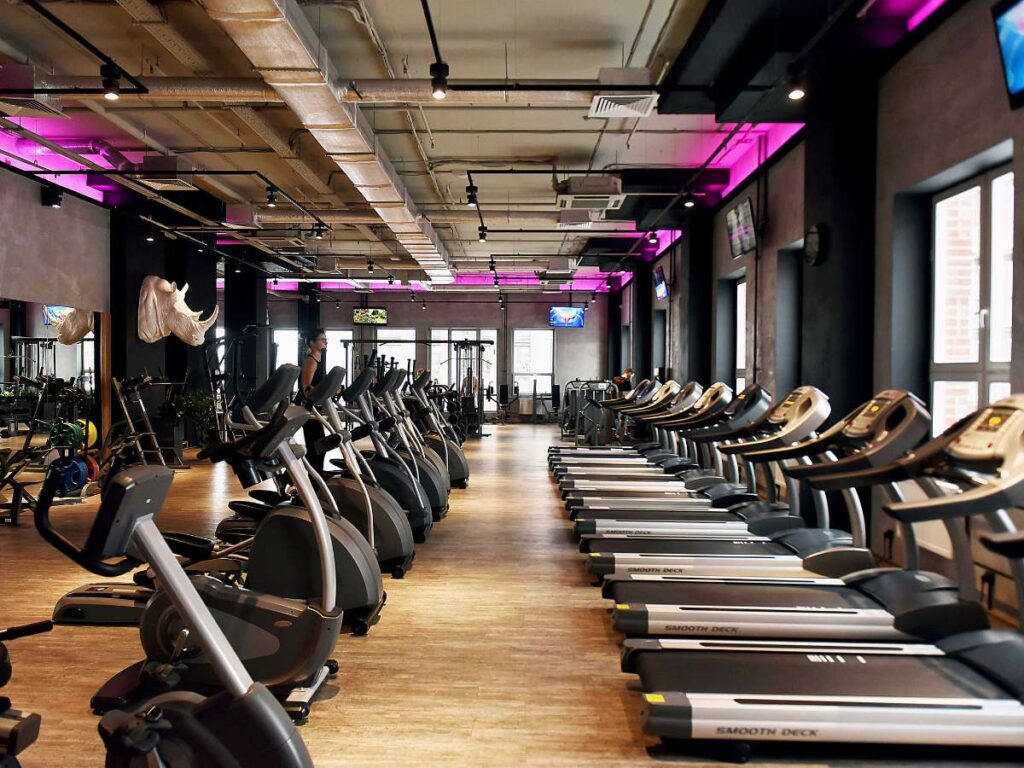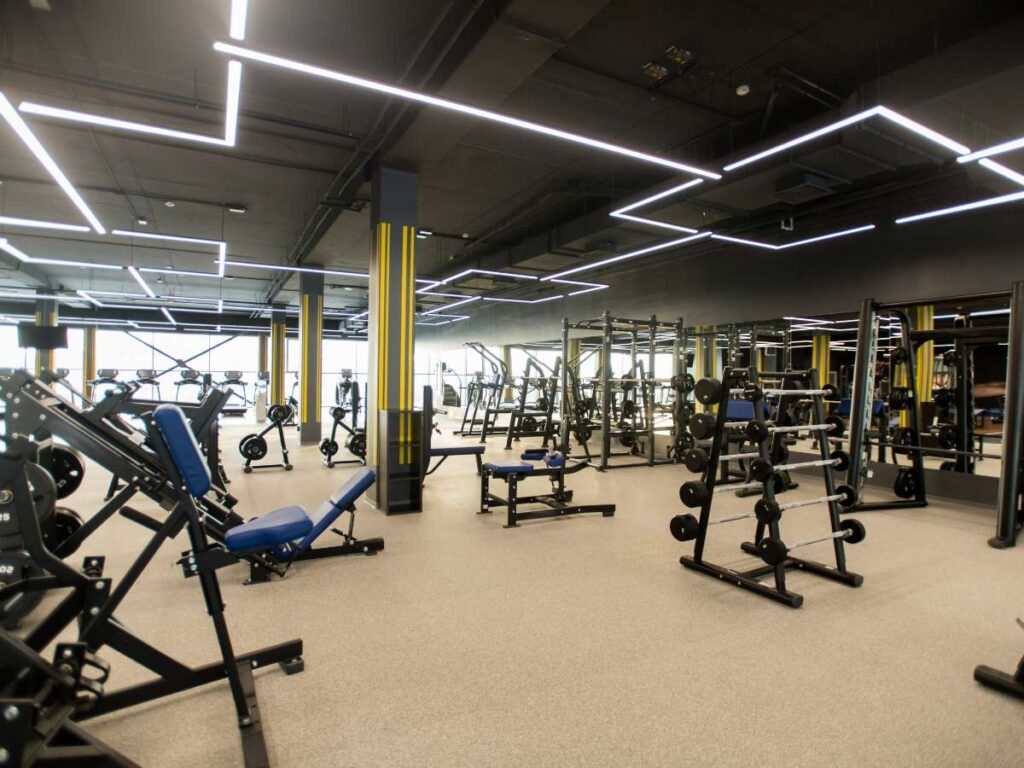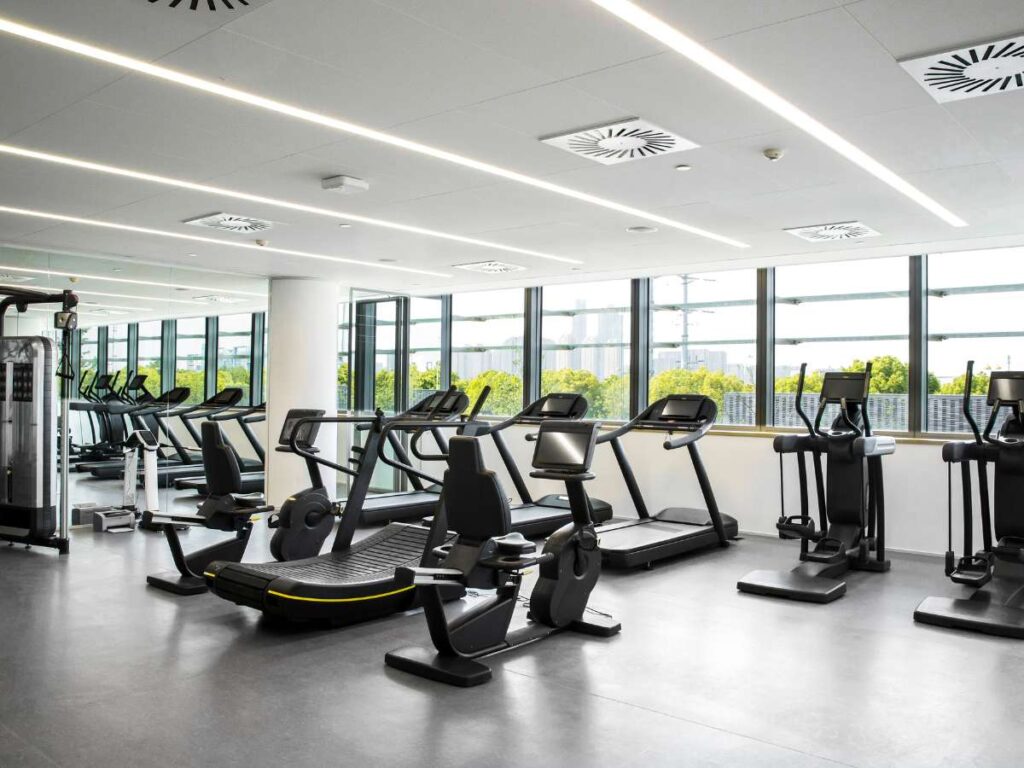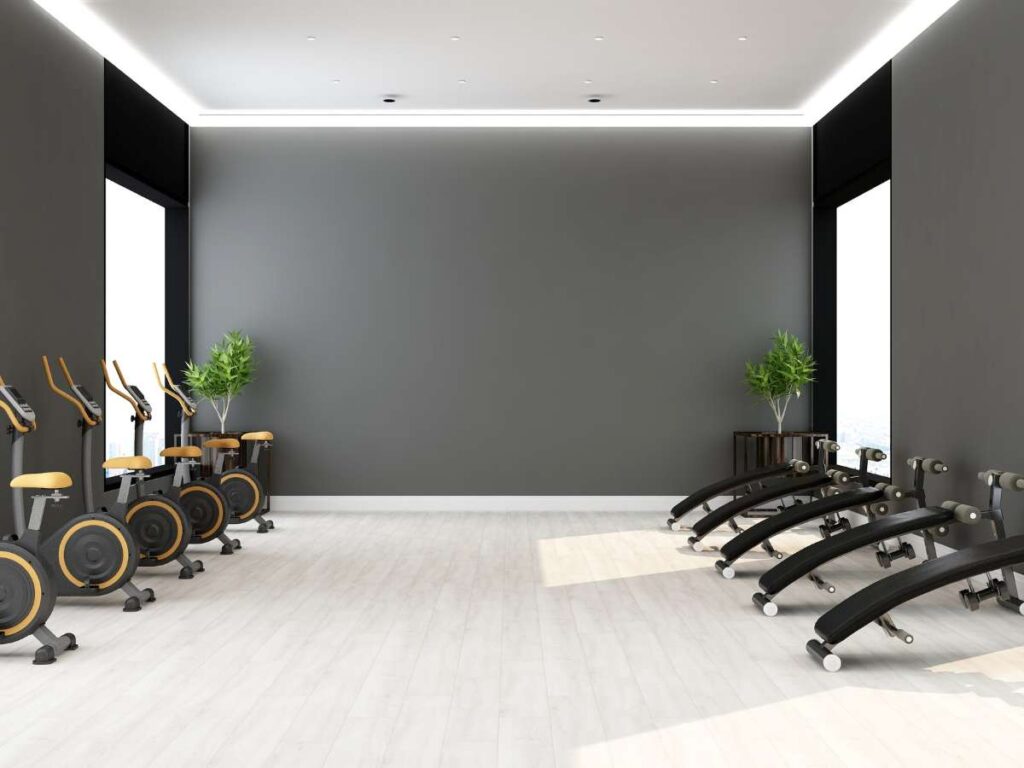Are you thinking about starting a corporate gym but unsure where to begin? Building an in-office gym is a great way to boost employee health and enhance your company’s image.
As an experienced gym expert, I’ve helped businesses successfully implement corporate gyms that not only improve employee well-being but also increase productivity. I
Starting a corporate gym is a smart investment for businesses that care about their employees’ health. By creating a convenient space for fitness, you promote a positive work environment that benefits both the company and its staff.
In this guide, we’ll cover key aspects of starting a corporate gym, from its benefits to effective programs. You’ll also learn how to overcome challenges and build a successful gym for your company.
Keep reading to learn more!
Table of Contents
- 1. What Is a Corporate Gym?
- 2. Benefits of Having a Corporate Gym
- 3. Types of Corporate Gym Models
- 4. Corporate Gym Programs and Services
- 5. Measuring the ROI of a Corporate Gym
- 6. Challenges and Solutions in Implementing a Corporate Gym
- 7. 3 Tips for Establishing a Successful Corporate Gym
- Conclusion
- Dive Deeper Into Our Resources
1. What Is a Corporate Gym?
A corporate gym is a fitness facility provided by a company for its employees to encourage a healthy and active lifestyle. It is located within the office building or nearby, offering easy access for employees before, during, or after work. These gyms usually feature a range of equipment and amenities like treadmills, weights, and even group fitness classes to cater to different fitness levels and preferences.
The purpose of a corporate gym goes beyond physical health. It aims to boost employee morale, reduce stress, and increase overall productivity. Here’s the interesting part, by promoting wellness, companies create a positive work environment that can lead to improved job satisfaction and reduced absenteeism. Corporate gyms are becoming a key part of employee wellness programs in many businesses today.

2. Benefits of Having a Corporate Gym
Having a corporate gym offers many advantages that go beyond just fitness. It promotes a healthier lifestyle among employees while benefiting the company in multiple ways. Here are some key benefits:
- Improved Employee Health: Regular access to a gym helps employees stay active, reducing the risk of health problems like obesity, heart disease, and diabetes. Healthier employees are more energetic and productive at work.
- Increased Productivity: Exercise is known to boost mental focus and energy levels. Employees who work out regularly tend to be more alert and focused, which can lead to better work performance and efficiency.
- Boosted Morale: Providing a gym shows that the company cares about employee well-being. As a matter of fact, this can increase job satisfaction and boost overall morale, making employees feel more valued and motivated.
- Reduced Absenteeism: Healthier employees are less likely to take sick days. With regular exercise, the chances of illnesses are reduced, leading to fewer absences and more consistent attendance.

3. Types of Corporate Gym Models
Companies can choose from different types of corporate gym models, depending on their space, budget, and employee needs. Each model offers unique benefits and serves various fitness goals. Here are a few common corporate gym models:
On-Site Corporate Gym
This model involves having a fully equipped gym within the office building itself. It allows employees to work out before, during, or after work, making fitness more convenient and accessible. Sounds amazing, right?

Partnership with Local Gyms
Companies can partner with nearby gyms to offer discounted memberships to employees. This option reduces the need for in-house space and maintenance while still encouraging regular exercise.

Hybrid Gym Model
A combination of on-site facilities and partnerships with local gyms or virtual programs. This model provides employees with more options, catering to those who prefer working out in different environments or have varying schedules.

Pop-Up Fitness Spaces
Companies can set up temporary or rotating fitness areas in unused office spaces. These pop-up gyms offer a simple setup with basic equipment and can be moved or adjusted based on demand.

4. Corporate Gym Programs and Services
Offering a variety of programs and services in a corporate gym helps meet the diverse fitness needs of employees. These services enhance the gym experience, making it more engaging and effective for everyone. Here are some common programs and services found in corporate gyms:
Group Fitness Classes
Offering a variety of group fitness classes can engage employees and encourage participation in the corporate gym. Here are some popular options:
- Yoga: Focuses on flexibility, balance, and relaxation. Yoga classes help employees reduce stress and improve mental well-being, making it a popular choice for all fitness levels.
- Pilates: Concentrates on core strength, posture, and controlled movements. This low-impact workout is great for improving overall body strength and stability.
- Spin Classes: High-energy indoor cycling sessions that provide a great cardio workout. Spin classes are ideal for boosting cardiovascular health and burning calories.
- HIIT (High-Intensity Interval Training): Combines short bursts of intense exercise with periods of rest. This class is perfect for employees looking to improve endurance, strength, and burn fat in a shorter workout session.
- Zumba: A fun, dance-based cardio workout that combines fitness with upbeat music. Zumba is perfect for employees who enjoy a lively and social workout atmosphere.
Personal Training
Employees can benefit from one-on-one sessions with certified personal trainers. Did you know that this service allows for customized workout plans tailored to individual fitness levels and goals, offering personal guidance and support. Here is a table below that outlines examples of customized workout fitness plans tailored to individual needs:
Fitness Plan Example | Description | Ideal For |
Beginner Strength Training Plan | A 4-week program focusing on building foundational strength using bodyweight exercises like squats, push-ups, and light dumbbells. | Newcomers to fitness or employees with no prior experience. |
Weight Loss & Cardio Program | A 6-week plan combining HIIT (High-Intensity Interval Training) and steady-state cardio sessions like jogging or cycling. | Employees aiming for weight loss or improving endurance. |
Functional Fitness Plan | A plan focusing on improving daily movement patterns using exercises like squats, lunges, deadlifts, and core exercises. | Employees with desk jobs or limited mobility. |
Muscle Building Plan | An 8-week program with resistance training targeting major muscle groups using weights and progressive overload techniques. | Employees seeking to gain muscle and improve physical fitness. |
Flexibility & Mobility Plan | A 4-week plan incorporating dynamic stretches, yoga routines, and mobility exercises for improved flexibility and joint mobility. | Employees with tight muscles or who sit for long periods. |
Core Strength Program | A 6-week program focusing on core exercises like planks, crunches, and stability ball workouts to strengthen abdominal and lower back muscles. | Employees with back pain or poor posture. |
Fitness Challenges
Organizing fitness challenges on a monthly or quarterly basis is an effective way to motivate employees to stay active and engaged with the corporate gym. These challenges promote healthy competition while providing a fun and supportive environment for employees to pursue their fitness goals. Here are some examples of popular fitness challenges:
- Step Challenge: Employees track their daily steps using fitness trackers or mobile apps. The goal is to reach a specific step count over a period of time, such as 10,000 steps a day for a month. Participants can compete individually or as teams, with prizes awarded to those who achieve the highest step counts.
- Weight Loss Challenge: Employees set personal weight loss goals and track their progress over several weeks or months. This challenge encourages healthy eating habits and regular exercise, with incentives like free personal training sessions or gym merchandise for those who achieve the most significant results.
- Distance Challenge: Participants aim to cover a certain distance, whether by running, walking, cycling, or swimming, over a set period. For example, a “100-mile challenge” could encourage employees to accumulate 100 miles of exercise over a month, either individually or as part of a team.
Health Assessments
Offering regular health assessments, such as BMI checks, fitness testing, or posture assessments, helps employees track their progress. These assessments provide valuable feedback and motivation for employees to stay committed to their fitness journey.
5. Measuring the ROI of a Corporate Gym
Measuring the return on investment (ROI) of a corporate gym is crucial for evaluating its impact on both the employees and the business. The ROI can be seen in terms of improved employee health, reduced absenteeism, and increased productivity. Here are a few ways to measure it:
Employee Health Improvements
Regular fitness activities often lead to better health outcomes. I guess tracking reductions in sick days, fewer visits to doctors, and overall health improvements among employees can indicate the positive effects of the gym on their well-being.
Productivity Gains
A healthier workforce tends to be more focused and productive. Monitoring improvements in employee output, task completion, and overall work efficiency can highlight how a corporate gym contributes to better job performance.
Employee Engagement and Retention
A corporate gym can improve job satisfaction and loyalty. Surveying employees on their gym usage, job satisfaction, and engagement can help determine if the gym is positively influencing employee retention and morale.
Participation Rates
Tracking how often employees use the gym and participate in fitness programs provides direct insight into the gym’s value. High usage rates indicate that the gym is serving its purpose, contributing to overall employee health and satisfaction.
6. Challenges and Solutions in Implementing a Corporate Gym
Setting up a corporate gym comes with its own set of challenges, from space limitations to ensuring consistent employee participation. However, with careful planning, these obstacles can be overcome. Here are some common challenges and their solutions:
Limited Space
Many offices may not have the space for a full gym setup. This can make it difficult to accommodate large pieces of equipment.
Solution: Maximize the available area by choosing versatile equipment that fits smaller spaces while still providing a full workout experience. Invest in small equipment just like dumbbells from YR Fitness. It is easy to store, making them ideal for limited spaces without sacrificing workout variety.
Budget Constraints
Corporate gyms can be expensive to set up, especially when trying to purchase all the necessary equipment upfront.
Solution: Start small with essential equipment, and expand as the budget allows. I suggest considering partnering with local gyms to offer discounted memberships to employees.
Low Employee Engagement
Even after setting up the gym, some employees may not be motivated to use it regularly.
Solution: Introduce fitness challenges, group classes, or incentive programs, such as rewarding consistent gym users with perks like extra time off or wellness-related gifts.
Maintenance and Upkeep
Keeping gym equipment in good condition requires regular maintenance, which can be a challenge for businesses with limited staff or resources.
Solution: Assign a dedicated staff member for maintenance or outsource the job to a fitness equipment provider to ensure the gym remains clean, safe, and fully operational.
7. 3 Tips for Establishing a Successful Corporate Gym
When establishing a corporate gym, it’s essential to focus on creating an environment that supports employee well-being and promotes consistent engagement. Here are some key tips to help make your corporate gym a success:
#1 Google Sheet Form
Look for an easy and accessible way to survey employees on their needs for the corporate gym, such as using a Google Sheet Form. For example, if your employees prefer specific equipment or fitness classes, you can quickly gather and analyze this feedback to design a gym that meets their preferences.
#2 10+ Years Experience
Confirm that your gym equipment comes from a manufacturer with over 10 years of experience like YR Fitness. Please remember that if your goal is to have durable machines that can withstand heavy usage, choosing a reputable supplier ensures the equipment will last longer and be safe for daily use by your employees.
#3 Work-Life Balance Seminar
Hosting a work-life balance seminar offers valuable insights into how employees can prioritize their health. In fact, according to Hubstaff, 77% of employees report experiencing burnout at their job. If employees struggle to find time for fitness, this seminar can highlight that “health is wealth,” encouraging them to use the corporate gym and maintain a healthier work-life balance.
Conclusion
In conclusion, creating a successful corporate gym depends on understanding the unique needs of your employees and selecting the right equipment and services to meet those needs. By knowing the guidelines outlined above, you can build a gym that promotes employee well-being, productivity, and a positive work environment.
We hope this comprehensive guide has provided you with valuable insights on how to start a corporate gym. If you are looking for a high-quality gym equipment, consider YR Fitness. We take pride in offering durable a equipment tailored to fit any space. Contact us today for more details!
Dive Deeper Into Our Resources
Looking for more diverse product options? Browse through our handpicked selections:
For some insightful reads, we’ve curated a list of recommended articles just for you:
Still haven’t found what you’re looking for? Don’t hesitate to contact us. We’re available around the clock to assist you.
Related articles:





